Case Study: Crime Trends, Control, and Policy in the United States
VerifiedAdded on 2022/09/25
|15
|3918
|21
Case Study
AI Summary
This case study provides an in-depth analysis of crime and crime control in the United States. It examines the influence of globalization, key crime trends, and various crime control strategies, including penal policies and their political economy type. The study delves into the US's international legal background, addressing state crime and human rights abuses. It explores the decline in crime rates, the impact of neoliberal policies, and the application of criminological theories like the Dignan and Cavadino model and rational choice theory. The study also discusses the influence of international law, including the role of international instruments, on the US criminal justice system, particularly in combating organized crime and protecting human rights. The analysis highlights political biases within the criminal justice system, especially concerning minority groups, and the evolution of organized crime, as well as the role of the Department of Justice in coordinating efforts to combat it.
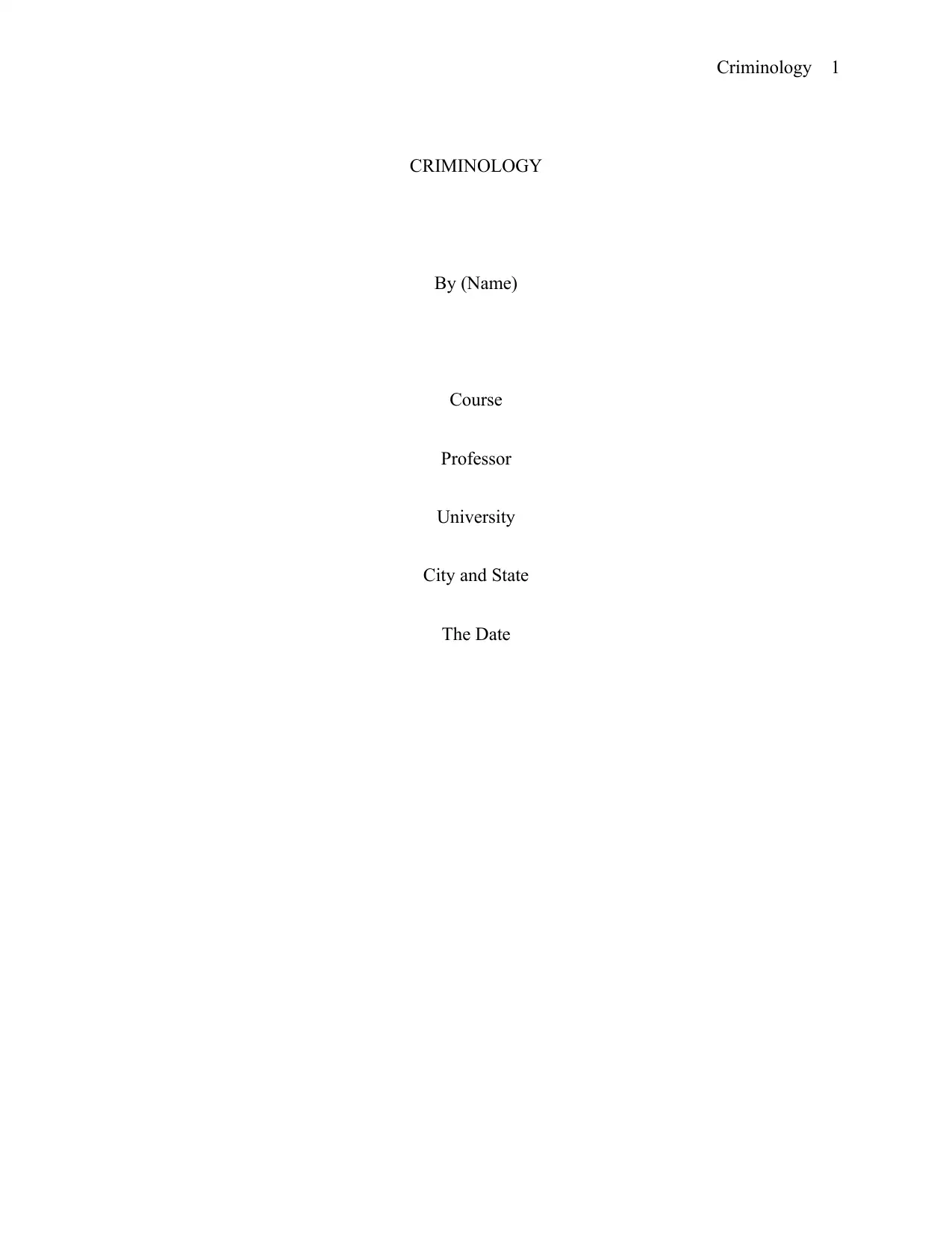
Criminology 1
CRIMINOLOGY
By (Name)
Course
Professor
University
City and State
The Date
CRIMINOLOGY
By (Name)
Course
Professor
University
City and State
The Date
Paraphrase This Document
Need a fresh take? Get an instant paraphrase of this document with our AI Paraphraser
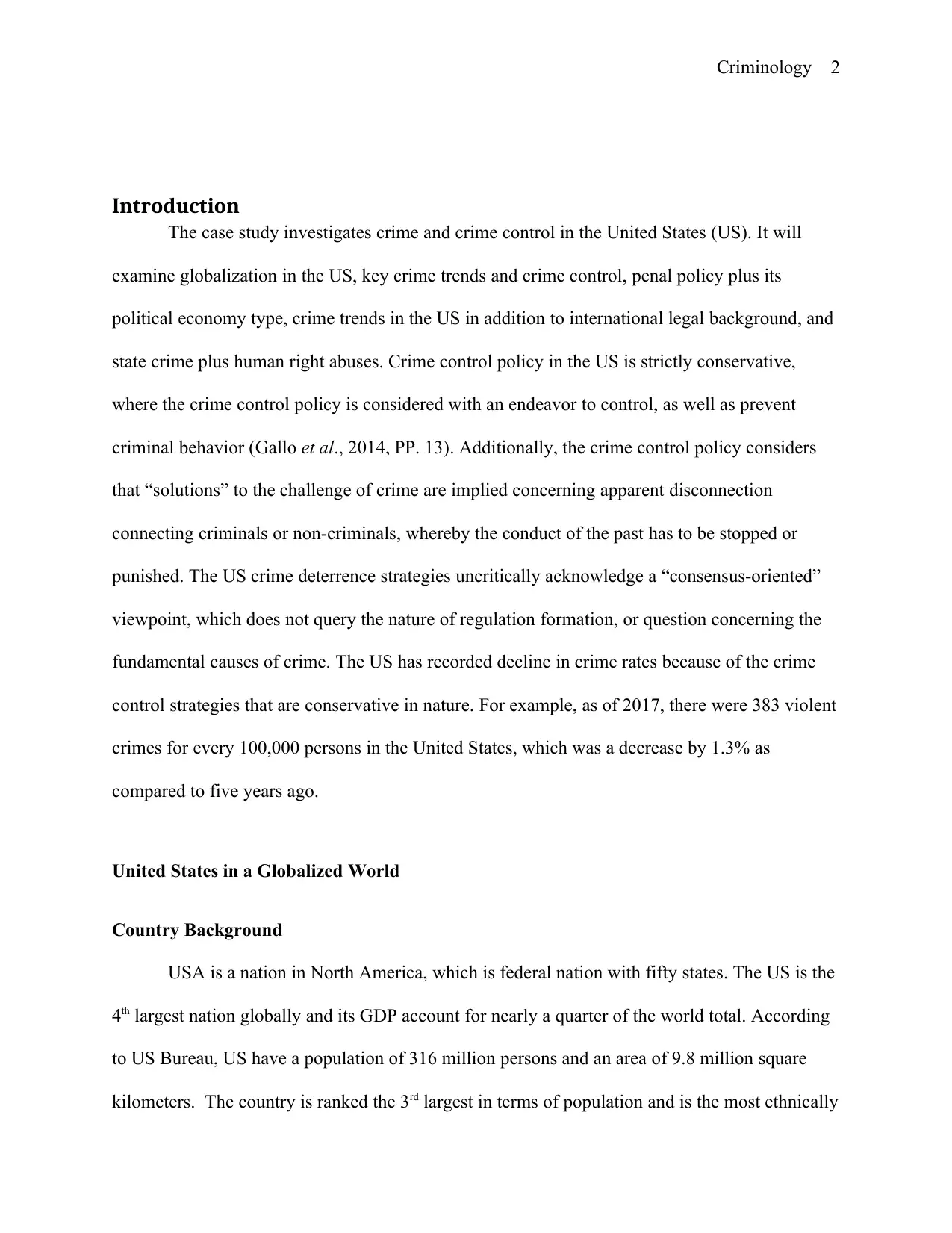
Criminology 2
Introduction
The case study investigates crime and crime control in the United States (US). It will
examine globalization in the US, key crime trends and crime control, penal policy plus its
political economy type, crime trends in the US in addition to international legal background, and
state crime plus human right abuses. Crime control policy in the US is strictly conservative,
where the crime control policy is considered with an endeavor to control, as well as prevent
criminal behavior (Gallo et al., 2014, PP. 13). Additionally, the crime control policy considers
that “solutions” to the challenge of crime are implied concerning apparent disconnection
connecting criminals or non-criminals, whereby the conduct of the past has to be stopped or
punished. The US crime deterrence strategies uncritically acknowledge a “consensus-oriented”
viewpoint, which does not query the nature of regulation formation, or question concerning the
fundamental causes of crime. The US has recorded decline in crime rates because of the crime
control strategies that are conservative in nature. For example, as of 2017, there were 383 violent
crimes for every 100,000 persons in the United States, which was a decrease by 1.3% as
compared to five years ago.
United States in a Globalized World
Country Background
USA is a nation in North America, which is federal nation with fifty states. The US is the
4th largest nation globally and its GDP account for nearly a quarter of the world total. According
to US Bureau, US have a population of 316 million persons and an area of 9.8 million square
kilometers. The country is ranked the 3rd largest in terms of population and is the most ethnically
Introduction
The case study investigates crime and crime control in the United States (US). It will
examine globalization in the US, key crime trends and crime control, penal policy plus its
political economy type, crime trends in the US in addition to international legal background, and
state crime plus human right abuses. Crime control policy in the US is strictly conservative,
where the crime control policy is considered with an endeavor to control, as well as prevent
criminal behavior (Gallo et al., 2014, PP. 13). Additionally, the crime control policy considers
that “solutions” to the challenge of crime are implied concerning apparent disconnection
connecting criminals or non-criminals, whereby the conduct of the past has to be stopped or
punished. The US crime deterrence strategies uncritically acknowledge a “consensus-oriented”
viewpoint, which does not query the nature of regulation formation, or question concerning the
fundamental causes of crime. The US has recorded decline in crime rates because of the crime
control strategies that are conservative in nature. For example, as of 2017, there were 383 violent
crimes for every 100,000 persons in the United States, which was a decrease by 1.3% as
compared to five years ago.
United States in a Globalized World
Country Background
USA is a nation in North America, which is federal nation with fifty states. The US is the
4th largest nation globally and its GDP account for nearly a quarter of the world total. According
to US Bureau, US have a population of 316 million persons and an area of 9.8 million square
kilometers. The country is ranked the 3rd largest in terms of population and is the most ethnically
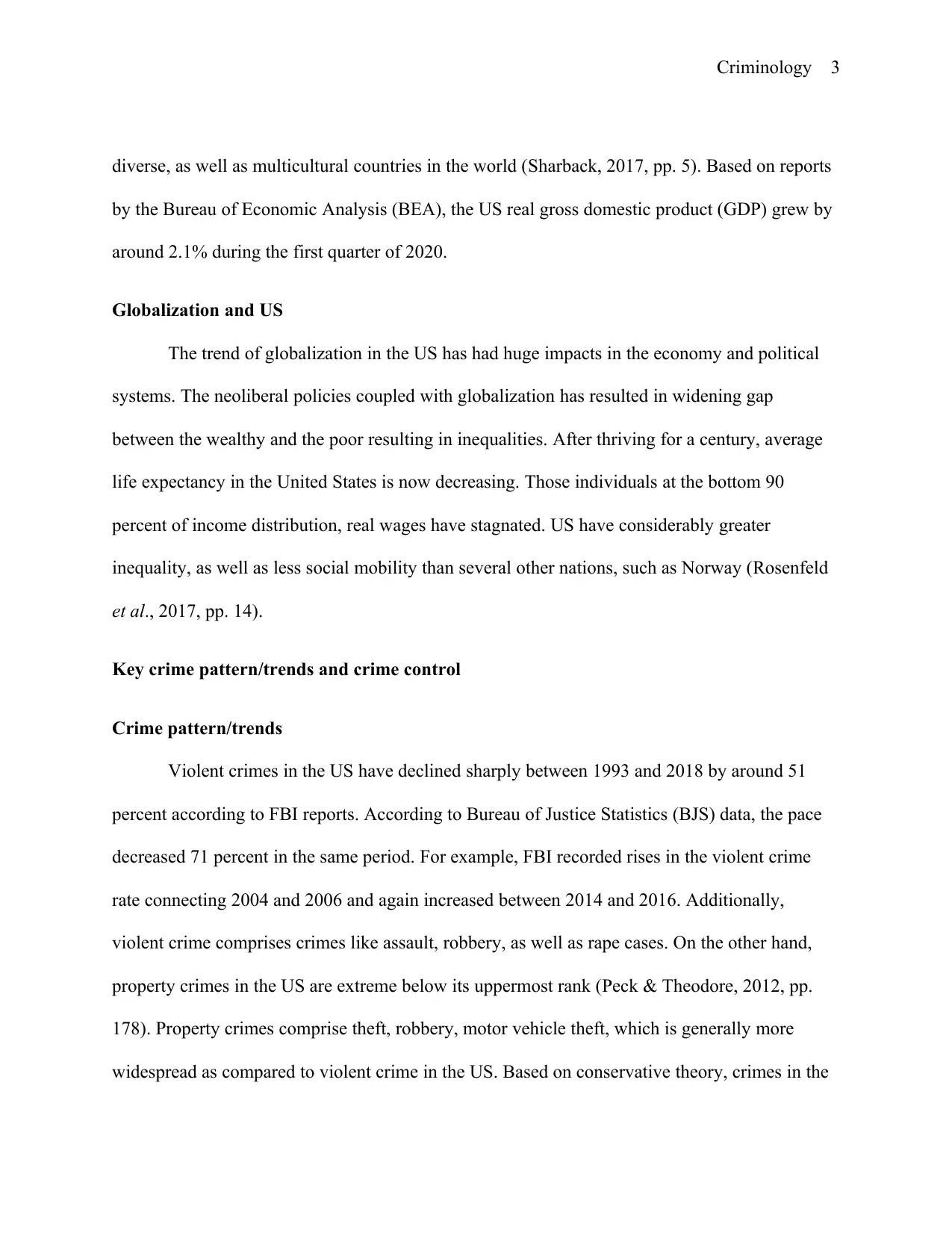
Criminology 3
diverse, as well as multicultural countries in the world (Sharback, 2017, pp. 5). Based on reports
by the Bureau of Economic Analysis (BEA), the US real gross domestic product (GDP) grew by
around 2.1% during the first quarter of 2020.
Globalization and US
The trend of globalization in the US has had huge impacts in the economy and political
systems. The neoliberal policies coupled with globalization has resulted in widening gap
between the wealthy and the poor resulting in inequalities. After thriving for a century, average
life expectancy in the United States is now decreasing. Those individuals at the bottom 90
percent of income distribution, real wages have stagnated. US have considerably greater
inequality, as well as less social mobility than several other nations, such as Norway (Rosenfeld
et al., 2017, pp. 14).
Key crime pattern/trends and crime control
Crime pattern/trends
Violent crimes in the US have declined sharply between 1993 and 2018 by around 51
percent according to FBI reports. According to Bureau of Justice Statistics (BJS) data, the pace
decreased 71 percent in the same period. For example, FBI recorded rises in the violent crime
rate connecting 2004 and 2006 and again increased between 2014 and 2016. Additionally,
violent crime comprises crimes like assault, robbery, as well as rape cases. On the other hand,
property crimes in the US are extreme below its uppermost rank (Peck & Theodore, 2012, pp.
178). Property crimes comprise theft, robbery, motor vehicle theft, which is generally more
widespread as compared to violent crime in the US. Based on conservative theory, crimes in the
diverse, as well as multicultural countries in the world (Sharback, 2017, pp. 5). Based on reports
by the Bureau of Economic Analysis (BEA), the US real gross domestic product (GDP) grew by
around 2.1% during the first quarter of 2020.
Globalization and US
The trend of globalization in the US has had huge impacts in the economy and political
systems. The neoliberal policies coupled with globalization has resulted in widening gap
between the wealthy and the poor resulting in inequalities. After thriving for a century, average
life expectancy in the United States is now decreasing. Those individuals at the bottom 90
percent of income distribution, real wages have stagnated. US have considerably greater
inequality, as well as less social mobility than several other nations, such as Norway (Rosenfeld
et al., 2017, pp. 14).
Key crime pattern/trends and crime control
Crime pattern/trends
Violent crimes in the US have declined sharply between 1993 and 2018 by around 51
percent according to FBI reports. According to Bureau of Justice Statistics (BJS) data, the pace
decreased 71 percent in the same period. For example, FBI recorded rises in the violent crime
rate connecting 2004 and 2006 and again increased between 2014 and 2016. Additionally,
violent crime comprises crimes like assault, robbery, as well as rape cases. On the other hand,
property crimes in the US are extreme below its uppermost rank (Peck & Theodore, 2012, pp.
178). Property crimes comprise theft, robbery, motor vehicle theft, which is generally more
widespread as compared to violent crime in the US. Based on conservative theory, crimes in the
⊘ This is a preview!⊘
Do you want full access?
Subscribe today to unlock all pages.

Trusted by 1+ million students worldwide

Criminology 4
US are influenced by the social order making individuals to adhere to established morals in
society (Gallo et al., 2014 pp. 14).
According to Dignan and Cavadino model there exist variations in incarceration rates
based on conflicting political economy. The theory claim that in neo-liberal nations there is
elevated rates of imprisonment since they follow economic, as well as political priorities that
US are influenced by the social order making individuals to adhere to established morals in
society (Gallo et al., 2014 pp. 14).
According to Dignan and Cavadino model there exist variations in incarceration rates
based on conflicting political economy. The theory claim that in neo-liberal nations there is
elevated rates of imprisonment since they follow economic, as well as political priorities that
Paraphrase This Document
Need a fresh take? Get an instant paraphrase of this document with our AI Paraphraser
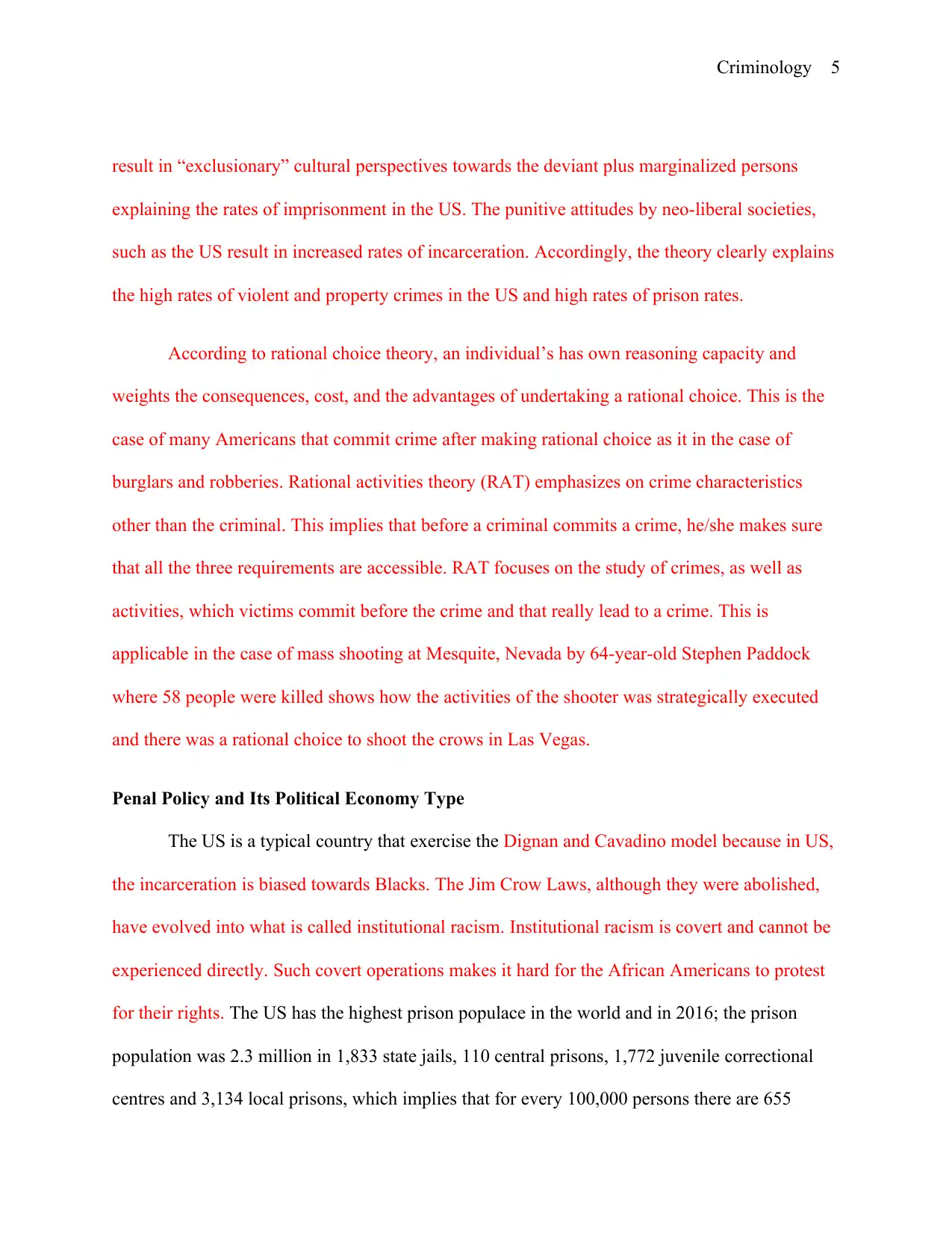
Criminology 5
result in “exclusionary” cultural perspectives towards the deviant plus marginalized persons
explaining the rates of imprisonment in the US. The punitive attitudes by neo-liberal societies,
such as the US result in increased rates of incarceration. Accordingly, the theory clearly explains
the high rates of violent and property crimes in the US and high rates of prison rates.
According to rational choice theory, an individual’s has own reasoning capacity and
weights the consequences, cost, and the advantages of undertaking a rational choice. This is the
case of many Americans that commit crime after making rational choice as it in the case of
burglars and robberies. Rational activities theory (RAT) emphasizes on crime characteristics
other than the criminal. This implies that before a criminal commits a crime, he/she makes sure
that all the three requirements are accessible. RAT focuses on the study of crimes, as well as
activities, which victims commit before the crime and that really lead to a crime. This is
applicable in the case of mass shooting at Mesquite, Nevada by 64-year-old Stephen Paddock
where 58 people were killed shows how the activities of the shooter was strategically executed
and there was a rational choice to shoot the crows in Las Vegas.
Penal Policy and Its Political Economy Type
The US is a typical country that exercise the Dignan and Cavadino model because in US,
the incarceration is biased towards Blacks. The Jim Crow Laws, although they were abolished,
have evolved into what is called institutional racism. Institutional racism is covert and cannot be
experienced directly. Such covert operations makes it hard for the African Americans to protest
for their rights. The US has the highest prison populace in the world and in 2016; the prison
population was 2.3 million in 1,833 state jails, 110 central prisons, 1,772 juvenile correctional
centres and 3,134 local prisons, which implies that for every 100,000 persons there are 655
result in “exclusionary” cultural perspectives towards the deviant plus marginalized persons
explaining the rates of imprisonment in the US. The punitive attitudes by neo-liberal societies,
such as the US result in increased rates of incarceration. Accordingly, the theory clearly explains
the high rates of violent and property crimes in the US and high rates of prison rates.
According to rational choice theory, an individual’s has own reasoning capacity and
weights the consequences, cost, and the advantages of undertaking a rational choice. This is the
case of many Americans that commit crime after making rational choice as it in the case of
burglars and robberies. Rational activities theory (RAT) emphasizes on crime characteristics
other than the criminal. This implies that before a criminal commits a crime, he/she makes sure
that all the three requirements are accessible. RAT focuses on the study of crimes, as well as
activities, which victims commit before the crime and that really lead to a crime. This is
applicable in the case of mass shooting at Mesquite, Nevada by 64-year-old Stephen Paddock
where 58 people were killed shows how the activities of the shooter was strategically executed
and there was a rational choice to shoot the crows in Las Vegas.
Penal Policy and Its Political Economy Type
The US is a typical country that exercise the Dignan and Cavadino model because in US,
the incarceration is biased towards Blacks. The Jim Crow Laws, although they were abolished,
have evolved into what is called institutional racism. Institutional racism is covert and cannot be
experienced directly. Such covert operations makes it hard for the African Americans to protest
for their rights. The US has the highest prison populace in the world and in 2016; the prison
population was 2.3 million in 1,833 state jails, 110 central prisons, 1,772 juvenile correctional
centres and 3,134 local prisons, which implies that for every 100,000 persons there are 655
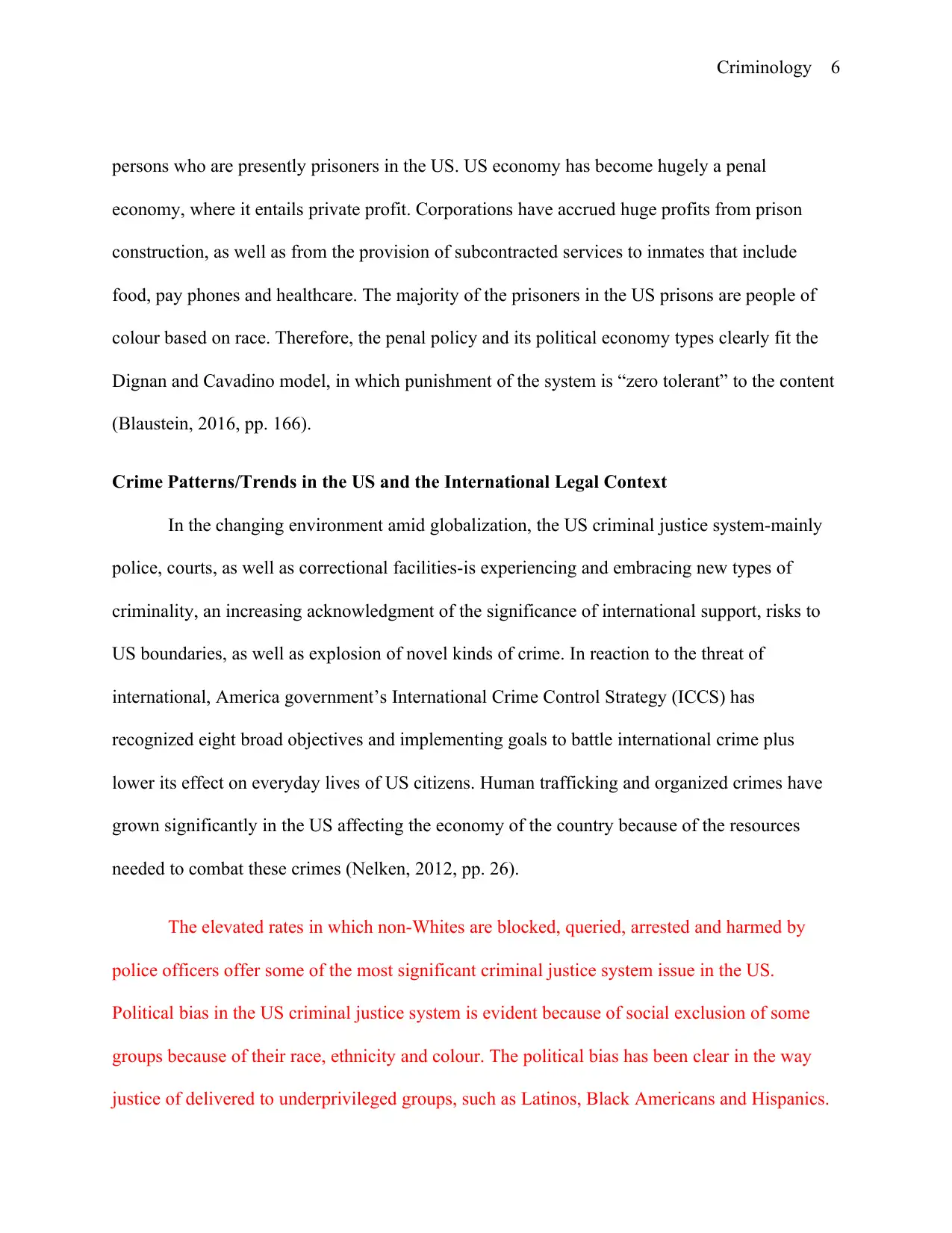
Criminology 6
persons who are presently prisoners in the US. US economy has become hugely a penal
economy, where it entails private profit. Corporations have accrued huge profits from prison
construction, as well as from the provision of subcontracted services to inmates that include
food, pay phones and healthcare. The majority of the prisoners in the US prisons are people of
colour based on race. Therefore, the penal policy and its political economy types clearly fit the
Dignan and Cavadino model, in which punishment of the system is “zero tolerant” to the content
(Blaustein, 2016, pp. 166).
Crime Patterns/Trends in the US and the International Legal Context
In the changing environment amid globalization, the US criminal justice system-mainly
police, courts, as well as correctional facilities-is experiencing and embracing new types of
criminality, an increasing acknowledgment of the significance of international support, risks to
US boundaries, as well as explosion of novel kinds of crime. In reaction to the threat of
international, America government’s International Crime Control Strategy (ICCS) has
recognized eight broad objectives and implementing goals to battle international crime plus
lower its effect on everyday lives of US citizens. Human trafficking and organized crimes have
grown significantly in the US affecting the economy of the country because of the resources
needed to combat these crimes (Nelken, 2012, pp. 26).
The elevated rates in which non-Whites are blocked, queried, arrested and harmed by
police officers offer some of the most significant criminal justice system issue in the US.
Political bias in the US criminal justice system is evident because of social exclusion of some
groups because of their race, ethnicity and colour. The political bias has been clear in the way
justice of delivered to underprivileged groups, such as Latinos, Black Americans and Hispanics.
persons who are presently prisoners in the US. US economy has become hugely a penal
economy, where it entails private profit. Corporations have accrued huge profits from prison
construction, as well as from the provision of subcontracted services to inmates that include
food, pay phones and healthcare. The majority of the prisoners in the US prisons are people of
colour based on race. Therefore, the penal policy and its political economy types clearly fit the
Dignan and Cavadino model, in which punishment of the system is “zero tolerant” to the content
(Blaustein, 2016, pp. 166).
Crime Patterns/Trends in the US and the International Legal Context
In the changing environment amid globalization, the US criminal justice system-mainly
police, courts, as well as correctional facilities-is experiencing and embracing new types of
criminality, an increasing acknowledgment of the significance of international support, risks to
US boundaries, as well as explosion of novel kinds of crime. In reaction to the threat of
international, America government’s International Crime Control Strategy (ICCS) has
recognized eight broad objectives and implementing goals to battle international crime plus
lower its effect on everyday lives of US citizens. Human trafficking and organized crimes have
grown significantly in the US affecting the economy of the country because of the resources
needed to combat these crimes (Nelken, 2012, pp. 26).
The elevated rates in which non-Whites are blocked, queried, arrested and harmed by
police officers offer some of the most significant criminal justice system issue in the US.
Political bias in the US criminal justice system is evident because of social exclusion of some
groups because of their race, ethnicity and colour. The political bias has been clear in the way
justice of delivered to underprivileged groups, such as Latinos, Black Americans and Hispanics.
⊘ This is a preview!⊘
Do you want full access?
Subscribe today to unlock all pages.

Trusted by 1+ million students worldwide
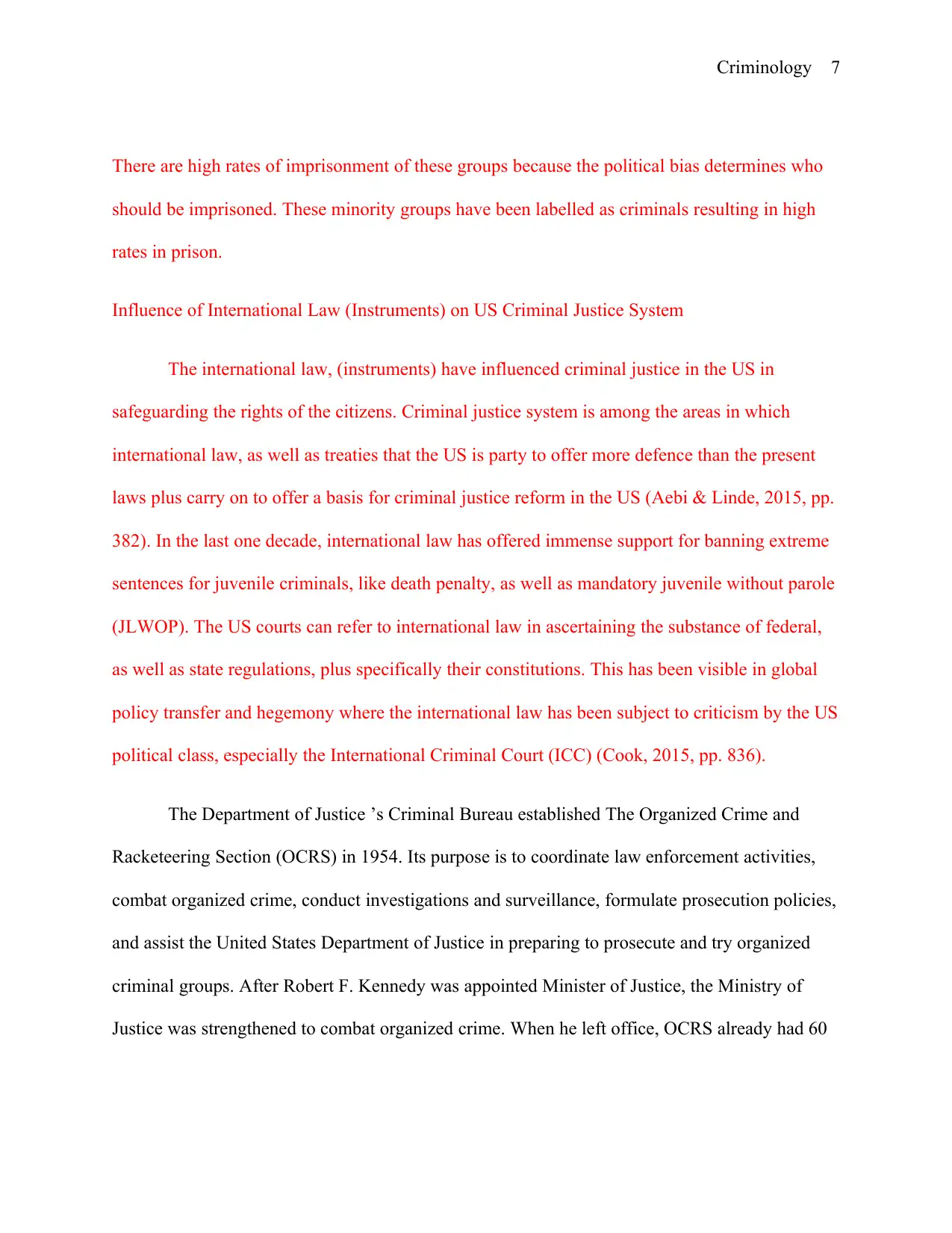
Criminology 7
There are high rates of imprisonment of these groups because the political bias determines who
should be imprisoned. These minority groups have been labelled as criminals resulting in high
rates in prison.
Influence of International Law (Instruments) on US Criminal Justice System
The international law, (instruments) have influenced criminal justice in the US in
safeguarding the rights of the citizens. Criminal justice system is among the areas in which
international law, as well as treaties that the US is party to offer more defence than the present
laws plus carry on to offer a basis for criminal justice reform in the US (Aebi & Linde, 2015, pp.
382). In the last one decade, international law has offered immense support for banning extreme
sentences for juvenile criminals, like death penalty, as well as mandatory juvenile without parole
(JLWOP). The US courts can refer to international law in ascertaining the substance of federal,
as well as state regulations, plus specifically their constitutions. This has been visible in global
policy transfer and hegemony where the international law has been subject to criticism by the US
political class, especially the International Criminal Court (ICC) (Cook, 2015, pp. 836).
The Department of Justice ’s Criminal Bureau established The Organized Crime and
Racketeering Section (OCRS) in 1954. Its purpose is to coordinate law enforcement activities,
combat organized crime, conduct investigations and surveillance, formulate prosecution policies,
and assist the United States Department of Justice in preparing to prosecute and try organized
criminal groups. After Robert F. Kennedy was appointed Minister of Justice, the Ministry of
Justice was strengthened to combat organized crime. When he left office, OCRS already had 60
There are high rates of imprisonment of these groups because the political bias determines who
should be imprisoned. These minority groups have been labelled as criminals resulting in high
rates in prison.
Influence of International Law (Instruments) on US Criminal Justice System
The international law, (instruments) have influenced criminal justice in the US in
safeguarding the rights of the citizens. Criminal justice system is among the areas in which
international law, as well as treaties that the US is party to offer more defence than the present
laws plus carry on to offer a basis for criminal justice reform in the US (Aebi & Linde, 2015, pp.
382). In the last one decade, international law has offered immense support for banning extreme
sentences for juvenile criminals, like death penalty, as well as mandatory juvenile without parole
(JLWOP). The US courts can refer to international law in ascertaining the substance of federal,
as well as state regulations, plus specifically their constitutions. This has been visible in global
policy transfer and hegemony where the international law has been subject to criticism by the US
political class, especially the International Criminal Court (ICC) (Cook, 2015, pp. 836).
The Department of Justice ’s Criminal Bureau established The Organized Crime and
Racketeering Section (OCRS) in 1954. Its purpose is to coordinate law enforcement activities,
combat organized crime, conduct investigations and surveillance, formulate prosecution policies,
and assist the United States Department of Justice in preparing to prosecute and try organized
criminal groups. After Robert F. Kennedy was appointed Minister of Justice, the Ministry of
Justice was strengthened to combat organized crime. When he left office, OCRS already had 60
Paraphrase This Document
Need a fresh take? Get an instant paraphrase of this document with our AI Paraphraser
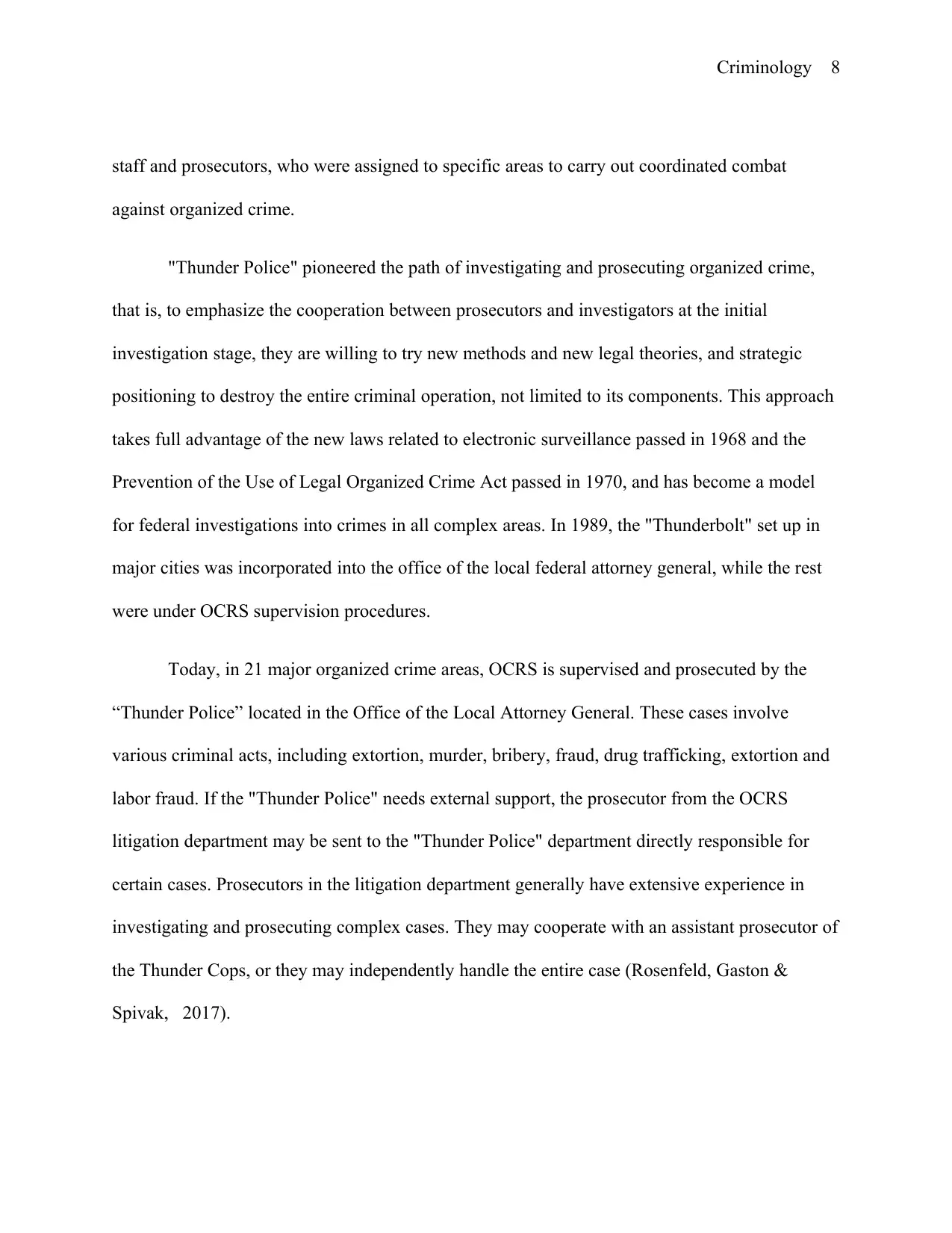
Criminology 8
staff and prosecutors, who were assigned to specific areas to carry out coordinated combat
against organized crime.
"Thunder Police" pioneered the path of investigating and prosecuting organized crime,
that is, to emphasize the cooperation between prosecutors and investigators at the initial
investigation stage, they are willing to try new methods and new legal theories, and strategic
positioning to destroy the entire criminal operation, not limited to its components. This approach
takes full advantage of the new laws related to electronic surveillance passed in 1968 and the
Prevention of the Use of Legal Organized Crime Act passed in 1970, and has become a model
for federal investigations into crimes in all complex areas. In 1989, the "Thunderbolt" set up in
major cities was incorporated into the office of the local federal attorney general, while the rest
were under OCRS supervision procedures.
Today, in 21 major organized crime areas, OCRS is supervised and prosecuted by the
“Thunder Police” located in the Office of the Local Attorney General. These cases involve
various criminal acts, including extortion, murder, bribery, fraud, drug trafficking, extortion and
labor fraud. If the "Thunder Police" needs external support, the prosecutor from the OCRS
litigation department may be sent to the "Thunder Police" department directly responsible for
certain cases. Prosecutors in the litigation department generally have extensive experience in
investigating and prosecuting complex cases. They may cooperate with an assistant prosecutor of
the Thunder Cops, or they may independently handle the entire case (Rosenfeld, Gaston &
Spivak, 2017).
staff and prosecutors, who were assigned to specific areas to carry out coordinated combat
against organized crime.
"Thunder Police" pioneered the path of investigating and prosecuting organized crime,
that is, to emphasize the cooperation between prosecutors and investigators at the initial
investigation stage, they are willing to try new methods and new legal theories, and strategic
positioning to destroy the entire criminal operation, not limited to its components. This approach
takes full advantage of the new laws related to electronic surveillance passed in 1968 and the
Prevention of the Use of Legal Organized Crime Act passed in 1970, and has become a model
for federal investigations into crimes in all complex areas. In 1989, the "Thunderbolt" set up in
major cities was incorporated into the office of the local federal attorney general, while the rest
were under OCRS supervision procedures.
Today, in 21 major organized crime areas, OCRS is supervised and prosecuted by the
“Thunder Police” located in the Office of the Local Attorney General. These cases involve
various criminal acts, including extortion, murder, bribery, fraud, drug trafficking, extortion and
labor fraud. If the "Thunder Police" needs external support, the prosecutor from the OCRS
litigation department may be sent to the "Thunder Police" department directly responsible for
certain cases. Prosecutors in the litigation department generally have extensive experience in
investigating and prosecuting complex cases. They may cooperate with an assistant prosecutor of
the Thunder Cops, or they may independently handle the entire case (Rosenfeld, Gaston &
Spivak, 2017).

Criminology 9
Through coordination and cooperation with the Federal Bureau of Investigation (FBI),
the Narcotics Control Agency (DEA), the Ministry of Labor, and other investigative agencies,
OCRS gives priority to participating in the development of national organized crime plans. In
addition to overseeing all federal organized crime cases, OCRS also closely controls the
government's use of the RICO law and the Violent Assistance Blackmail Act. OCRS ’RICO
office also provides prosecutors with comprehensive advice and training on how to use these
powerful methods in serious crime cases. Together with the FBI and other federal government
agencies, OCRS responds to the huge international organized criminal syndicate that is
expanding with the rapid globalization of the world economy. Along with US and foreign
collaborators, OCRS prosecutors traveled around the world to crack down on transnational
organized criminals and bring them to justice.
In every organized crime case, the US goal is always to find and convict the most senior
leaders of criminal organizations, and achieving this goal requires special prosecution tools. First
of all, they need regulations to specifically prohibit those who join criminal groups through
certain illegal activities. The most common law of this type is the Law on Preventing the Use of
Legal Organized Crime (RICO) passed in 1970. RICO provides heavy penalties for defendants
who commit crimes or predicate crimes through a certain organizational model, or conspire with
others in the above crimes. An organization can be a seemingly legal entity, such as a company
or union, or a group of people who jointly commit a crime.
The RICO law is particularly useful for organized crime. It allows prosecutors to
investigate the criminal activities of a person or a criminal group in detail. It is worth noting that
RICO includes a “return” clause, which allows prosecutors to prove the crime pattern listed in
Through coordination and cooperation with the Federal Bureau of Investigation (FBI),
the Narcotics Control Agency (DEA), the Ministry of Labor, and other investigative agencies,
OCRS gives priority to participating in the development of national organized crime plans. In
addition to overseeing all federal organized crime cases, OCRS also closely controls the
government's use of the RICO law and the Violent Assistance Blackmail Act. OCRS ’RICO
office also provides prosecutors with comprehensive advice and training on how to use these
powerful methods in serious crime cases. Together with the FBI and other federal government
agencies, OCRS responds to the huge international organized criminal syndicate that is
expanding with the rapid globalization of the world economy. Along with US and foreign
collaborators, OCRS prosecutors traveled around the world to crack down on transnational
organized criminals and bring them to justice.
In every organized crime case, the US goal is always to find and convict the most senior
leaders of criminal organizations, and achieving this goal requires special prosecution tools. First
of all, they need regulations to specifically prohibit those who join criminal groups through
certain illegal activities. The most common law of this type is the Law on Preventing the Use of
Legal Organized Crime (RICO) passed in 1970. RICO provides heavy penalties for defendants
who commit crimes or predicate crimes through a certain organizational model, or conspire with
others in the above crimes. An organization can be a seemingly legal entity, such as a company
or union, or a group of people who jointly commit a crime.
The RICO law is particularly useful for organized crime. It allows prosecutors to
investigate the criminal activities of a person or a criminal group in detail. It is worth noting that
RICO includes a “return” clause, which allows prosecutors to prove the crime pattern listed in
⊘ This is a preview!⊘
Do you want full access?
Subscribe today to unlock all pages.

Trusted by 1+ million students worldwide
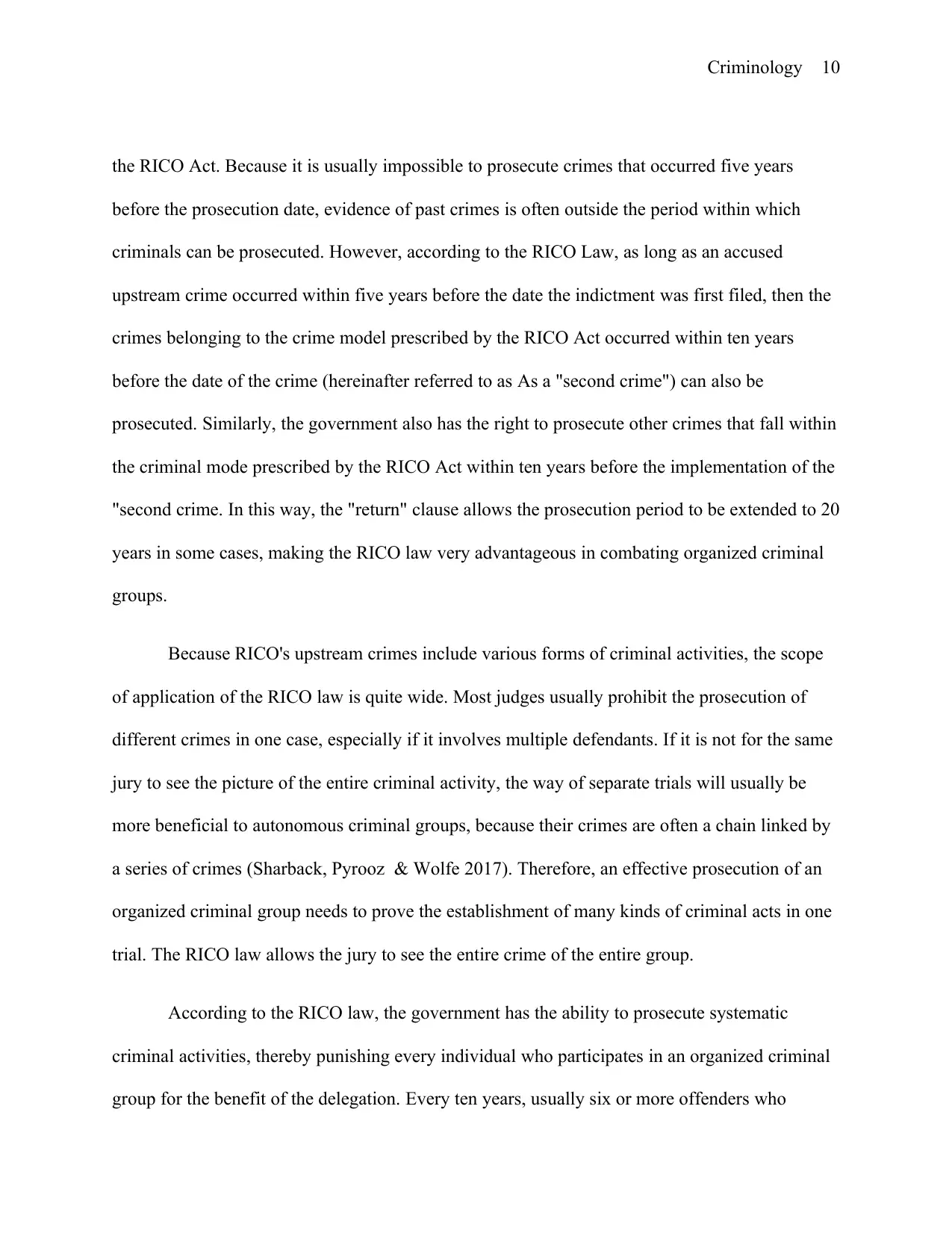
Criminology 10
the RICO Act. Because it is usually impossible to prosecute crimes that occurred five years
before the prosecution date, evidence of past crimes is often outside the period within which
criminals can be prosecuted. However, according to the RICO Law, as long as an accused
upstream crime occurred within five years before the date the indictment was first filed, then the
crimes belonging to the crime model prescribed by the RICO Act occurred within ten years
before the date of the crime (hereinafter referred to as As a "second crime") can also be
prosecuted. Similarly, the government also has the right to prosecute other crimes that fall within
the criminal mode prescribed by the RICO Act within ten years before the implementation of the
"second crime. In this way, the "return" clause allows the prosecution period to be extended to 20
years in some cases, making the RICO law very advantageous in combating organized criminal
groups.
Because RICO's upstream crimes include various forms of criminal activities, the scope
of application of the RICO law is quite wide. Most judges usually prohibit the prosecution of
different crimes in one case, especially if it involves multiple defendants. If it is not for the same
jury to see the picture of the entire criminal activity, the way of separate trials will usually be
more beneficial to autonomous criminal groups, because their crimes are often a chain linked by
a series of crimes (Sharback, Pyrooz & Wolfe 2017). Therefore, an effective prosecution of an
organized criminal group needs to prove the establishment of many kinds of criminal acts in one
trial. The RICO law allows the jury to see the entire crime of the entire group.
According to the RICO law, the government has the ability to prosecute systematic
criminal activities, thereby punishing every individual who participates in an organized criminal
group for the benefit of the delegation. Every ten years, usually six or more offenders who
the RICO Act. Because it is usually impossible to prosecute crimes that occurred five years
before the prosecution date, evidence of past crimes is often outside the period within which
criminals can be prosecuted. However, according to the RICO Law, as long as an accused
upstream crime occurred within five years before the date the indictment was first filed, then the
crimes belonging to the crime model prescribed by the RICO Act occurred within ten years
before the date of the crime (hereinafter referred to as As a "second crime") can also be
prosecuted. Similarly, the government also has the right to prosecute other crimes that fall within
the criminal mode prescribed by the RICO Act within ten years before the implementation of the
"second crime. In this way, the "return" clause allows the prosecution period to be extended to 20
years in some cases, making the RICO law very advantageous in combating organized criminal
groups.
Because RICO's upstream crimes include various forms of criminal activities, the scope
of application of the RICO law is quite wide. Most judges usually prohibit the prosecution of
different crimes in one case, especially if it involves multiple defendants. If it is not for the same
jury to see the picture of the entire criminal activity, the way of separate trials will usually be
more beneficial to autonomous criminal groups, because their crimes are often a chain linked by
a series of crimes (Sharback, Pyrooz & Wolfe 2017). Therefore, an effective prosecution of an
organized criminal group needs to prove the establishment of many kinds of criminal acts in one
trial. The RICO law allows the jury to see the entire crime of the entire group.
According to the RICO law, the government has the ability to prosecute systematic
criminal activities, thereby punishing every individual who participates in an organized criminal
group for the benefit of the delegation. Every ten years, usually six or more offenders who
Paraphrase This Document
Need a fresh take? Get an instant paraphrase of this document with our AI Paraphraser
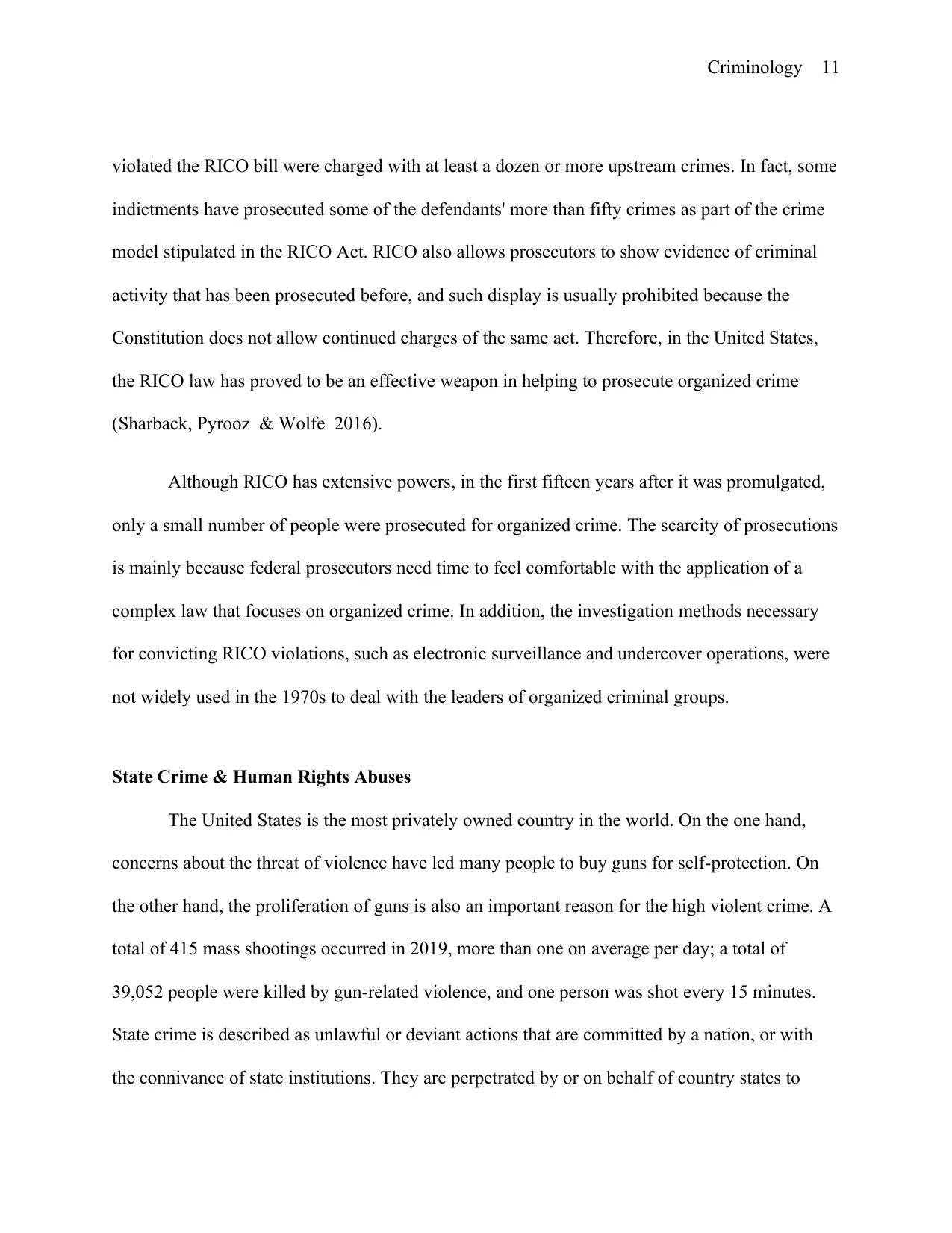
Criminology 11
violated the RICO bill were charged with at least a dozen or more upstream crimes. In fact, some
indictments have prosecuted some of the defendants' more than fifty crimes as part of the crime
model stipulated in the RICO Act. RICO also allows prosecutors to show evidence of criminal
activity that has been prosecuted before, and such display is usually prohibited because the
Constitution does not allow continued charges of the same act. Therefore, in the United States,
the RICO law has proved to be an effective weapon in helping to prosecute organized crime
(Sharback, Pyrooz & Wolfe 2016).
Although RICO has extensive powers, in the first fifteen years after it was promulgated,
only a small number of people were prosecuted for organized crime. The scarcity of prosecutions
is mainly because federal prosecutors need time to feel comfortable with the application of a
complex law that focuses on organized crime. In addition, the investigation methods necessary
for convicting RICO violations, such as electronic surveillance and undercover operations, were
not widely used in the 1970s to deal with the leaders of organized criminal groups.
State Crime & Human Rights Abuses
The United States is the most privately owned country in the world. On the one hand,
concerns about the threat of violence have led many people to buy guns for self-protection. On
the other hand, the proliferation of guns is also an important reason for the high violent crime. A
total of 415 mass shootings occurred in 2019, more than one on average per day; a total of
39,052 people were killed by gun-related violence, and one person was shot every 15 minutes.
State crime is described as unlawful or deviant actions that are committed by a nation, or with
the connivance of state institutions. They are perpetrated by or on behalf of country states to
violated the RICO bill were charged with at least a dozen or more upstream crimes. In fact, some
indictments have prosecuted some of the defendants' more than fifty crimes as part of the crime
model stipulated in the RICO Act. RICO also allows prosecutors to show evidence of criminal
activity that has been prosecuted before, and such display is usually prohibited because the
Constitution does not allow continued charges of the same act. Therefore, in the United States,
the RICO law has proved to be an effective weapon in helping to prosecute organized crime
(Sharback, Pyrooz & Wolfe 2016).
Although RICO has extensive powers, in the first fifteen years after it was promulgated,
only a small number of people were prosecuted for organized crime. The scarcity of prosecutions
is mainly because federal prosecutors need time to feel comfortable with the application of a
complex law that focuses on organized crime. In addition, the investigation methods necessary
for convicting RICO violations, such as electronic surveillance and undercover operations, were
not widely used in the 1970s to deal with the leaders of organized criminal groups.
State Crime & Human Rights Abuses
The United States is the most privately owned country in the world. On the one hand,
concerns about the threat of violence have led many people to buy guns for self-protection. On
the other hand, the proliferation of guns is also an important reason for the high violent crime. A
total of 415 mass shootings occurred in 2019, more than one on average per day; a total of
39,052 people were killed by gun-related violence, and one person was shot every 15 minutes.
State crime is described as unlawful or deviant actions that are committed by a nation, or with
the connivance of state institutions. They are perpetrated by or on behalf of country states to
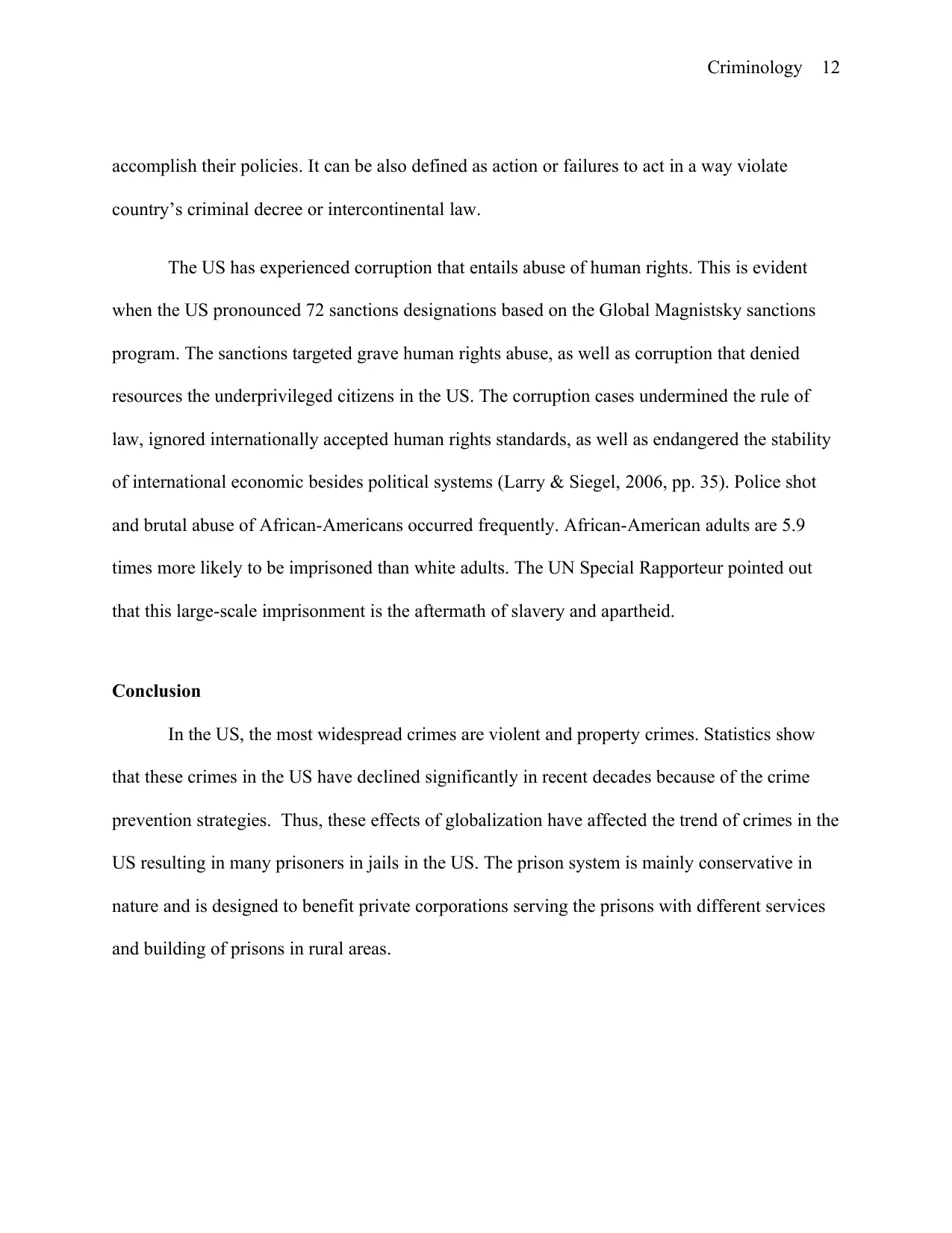
Criminology 12
accomplish their policies. It can be also defined as action or failures to act in a way violate
country’s criminal decree or intercontinental law.
The US has experienced corruption that entails abuse of human rights. This is evident
when the US pronounced 72 sanctions designations based on the Global Magnistsky sanctions
program. The sanctions targeted grave human rights abuse, as well as corruption that denied
resources the underprivileged citizens in the US. The corruption cases undermined the rule of
law, ignored internationally accepted human rights standards, as well as endangered the stability
of international economic besides political systems (Larry & Siegel, 2006, pp. 35). Police shot
and brutal abuse of African-Americans occurred frequently. African-American adults are 5.9
times more likely to be imprisoned than white adults. The UN Special Rapporteur pointed out
that this large-scale imprisonment is the aftermath of slavery and apartheid.
Conclusion
In the US, the most widespread crimes are violent and property crimes. Statistics show
that these crimes in the US have declined significantly in recent decades because of the crime
prevention strategies. Thus, these effects of globalization have affected the trend of crimes in the
US resulting in many prisoners in jails in the US. The prison system is mainly conservative in
nature and is designed to benefit private corporations serving the prisons with different services
and building of prisons in rural areas.
accomplish their policies. It can be also defined as action or failures to act in a way violate
country’s criminal decree or intercontinental law.
The US has experienced corruption that entails abuse of human rights. This is evident
when the US pronounced 72 sanctions designations based on the Global Magnistsky sanctions
program. The sanctions targeted grave human rights abuse, as well as corruption that denied
resources the underprivileged citizens in the US. The corruption cases undermined the rule of
law, ignored internationally accepted human rights standards, as well as endangered the stability
of international economic besides political systems (Larry & Siegel, 2006, pp. 35). Police shot
and brutal abuse of African-Americans occurred frequently. African-American adults are 5.9
times more likely to be imprisoned than white adults. The UN Special Rapporteur pointed out
that this large-scale imprisonment is the aftermath of slavery and apartheid.
Conclusion
In the US, the most widespread crimes are violent and property crimes. Statistics show
that these crimes in the US have declined significantly in recent decades because of the crime
prevention strategies. Thus, these effects of globalization have affected the trend of crimes in the
US resulting in many prisoners in jails in the US. The prison system is mainly conservative in
nature and is designed to benefit private corporations serving the prisons with different services
and building of prisons in rural areas.
⊘ This is a preview!⊘
Do you want full access?
Subscribe today to unlock all pages.

Trusted by 1+ million students worldwide
1 out of 15
Your All-in-One AI-Powered Toolkit for Academic Success.
+13062052269
info@desklib.com
Available 24*7 on WhatsApp / Email
![[object Object]](/_next/static/media/star-bottom.7253800d.svg)
Unlock your academic potential
Copyright © 2020–2025 A2Z Services. All Rights Reserved. Developed and managed by ZUCOL.


